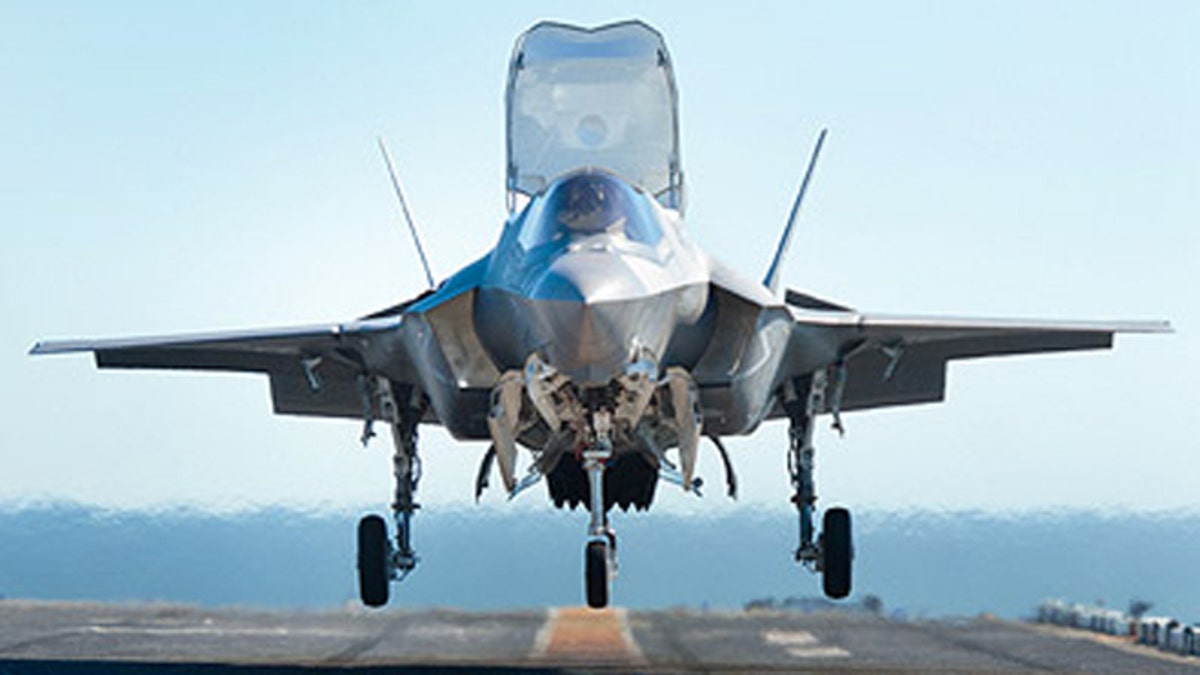
This photo shows an F-35 Lightning II jet. Lockheed Martin is making different variations of the plane for each branch of the service. (Lockheed Martin)
It’s as if the Pentagon went to Vegas with a boatload of bucks, gambled like crazy, lost its shirt, and now the whole nation must pay for an endless supply of Alka-Seltzer. That’s the story of the F-35.
Former U.K. defense chief Nick Harvey recently said this about the F-35 Joint Strike Fighter: “You could argue it was already one of the biggest white elephants in history a long time ago.” He added, there is “not a cat in hell’s chance” that the F-35 would be combat-ready by 2018.
In fact, the House Armed Services Committee is holding a hearing Wednesday on the troubled aircraft after news broke that due to "concerns about increased risk of injury to F-35 pilots," those under 136 pounds were restricted from flying the aircraft.
At a time when our national security is precarious, one would expect any reorganization of military forces and upgrades of defense equipment would mandate strong programs and efficient weaponry modeled for 21st century threats. Instead, we get an aircraft we might have been able to use to shoot down the Red Baron a century ago.
Our security depends on our being smart. There are deadly security risks out there that demand our attention. The F-35 will not fight ISIS or Al Qaeda or any other rogue enemy. It cannot protect us from car bombs or a loose nuke. Surely there are other ideas worth our collective taxes that will make us safer.
For this trillion-dollar-plus investment we get a plane that was crushed by an F-16 during a recent competition. The F-35 is far slower, with less than half the range, and sustained-turn- performance that is outdated by decades. It’s not just that billions of dollars are being wasted, it is that we need that money to spend on other programs.
To members of Congress, the F-35 somehow maintains its glossy allure. It is the most expensive weapon system in the history of the world of aeronautics. The plane can be operated solely with “computer laws” so that every simple or complex command can be programmed and not subjected to human error.
The F-35 engine measures small and therefore agile and swift. It looks good on the drawing board, but ugly on the balance sheet.
In monetary terms, the F-35 is a financial “black hole” devouring a large chunk of the defense budget. In his article for The Washington Times, “The deadly F-35 strike fighter,” Jed Babbin, former deputy undersecretary of Defense under George H.W. Bush calculates the cost of purchasing 2,500 F-35 jets to be around $400 billion, which does not even account for the annual $1 trillion price tag required for their upkeep and maintenance.
Congress and the Pentagon have to stop believing they have a license to throw good money after bad. Our security depends on our being smart. There are deadly security risks out there that demand our attention. The F-35 will not fight ISIS or Al Qaeda or any other rogue enemy. It cannot protect us from car bombs or a loose nuke. Surely there are other ideas worth our collective taxes that will make us safer.
The F-35 is so long on the drawing board, it needs to be upgraded, repaired, and reengineered constantly. By the time it’s ready to be operational, we may not even need it.
It’s time to stop gambling with our national security and cut our losses. Congress should walk out of the casino now.
Susan Shaer is the Executive Director of Women’s Action for New Directions, a national women’s peace and security organization.
